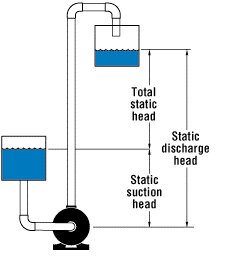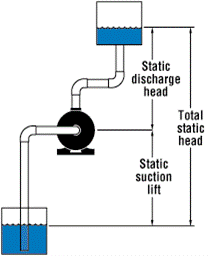Liquid Pump Installation Information
Relation of Pressure to Elevation
In a static liquid (a body of liquid at rest), the pressure difference between any two points is in direct proportion only to the vertical distance between the points.
Calculate this pressure difference by multiplying the vertical distance by the density (or vertical distance x density of water x specific gravity of the fluid).


Static Head
The hydraulic pressure at a point in a fluid when the liquid is at rest.
Friction Head
The loss in pressure or energy due to frictional losses in flow.
Discharge Head
The outlet pressure of a pump in operation.
Total Head
The total pressure difference between the inlet and outlet of a pump in operation.
Suction Head
The inlet pressure of a pump when above atmospheric pressure.
Suction Lift
The inlet pressure of a pump when below atmospheric pressure.
Effects of Specific Gravity
Specific gravity is an important factor to consider when sizing a pump. The specific gravity of your liquid can affect the output pressure of a pump a heavier liquid requires greater force than water (or a lighter liquid) to be lifted an identical vertical height.
The graph below compares the column heights needed to exert an equal pressure for liquids having different specific gravities. A 100-ft column of water (specific gravity of 1.0) exerts a pressure of 43.0 psi, while an 83-ft column of brine (a heavier liquid) and a 133-ft column of gasoline (a lighter liquid) are needed to exert the same pressure.

Suction Conditions
NPSHr (Net Positive Suction Head Required) determines the required suction head (maximum suction lift).
It is inherent to the design of the pump and is measured in feet of water. NPSHa (Net Positive Suction Head Available) is determined by the pipe system on the suction (inlet) side of the pump.
You must configure your system so NPSHa ≥ NPSHr (the head available from the system is greater than the head the pump requires). Failure to meet this requirement will cause reduced flow rate, cavitation, and vibration of the pump.

NPSHa = Ha + Hs - Hv - Hf
Ha = pressure on the liquid surface in the supply tank (ft H2O)(= 34 ft H2O at 1 atm)
Hs = suction head (+) or suction lift (-)
Hv = vapor pressure (ft H2O)
Hf = friction loss in the suction piping (ft H2O)
Tips to Keep in Mind:
- Restricting the inlet port size and the inlet pipe ID will cause cavitation and damage the pump.
- It is best to have a straight run of pipe leading into the pump inlet.
- The NPSHa must be greater than NPSHr of the system.